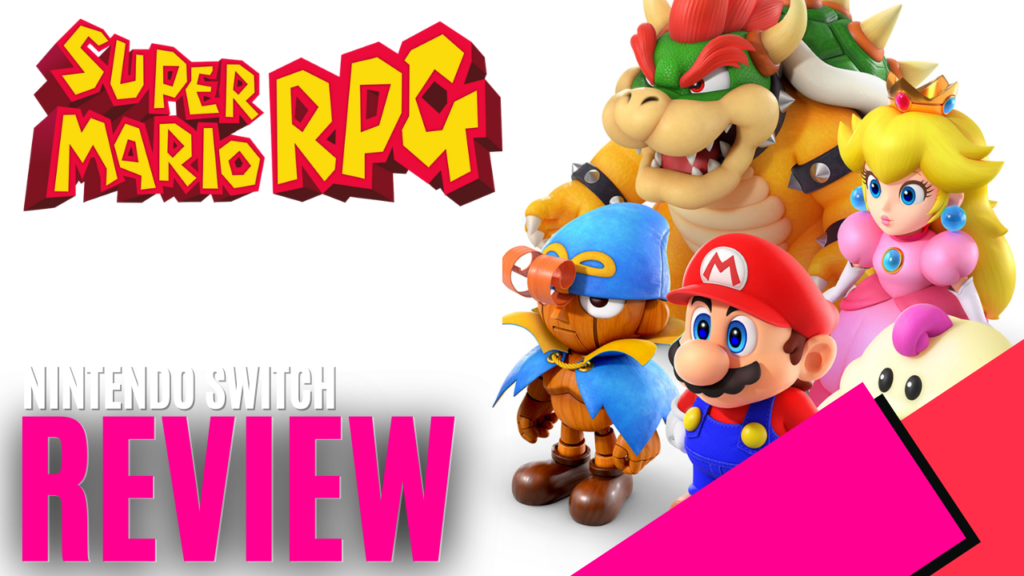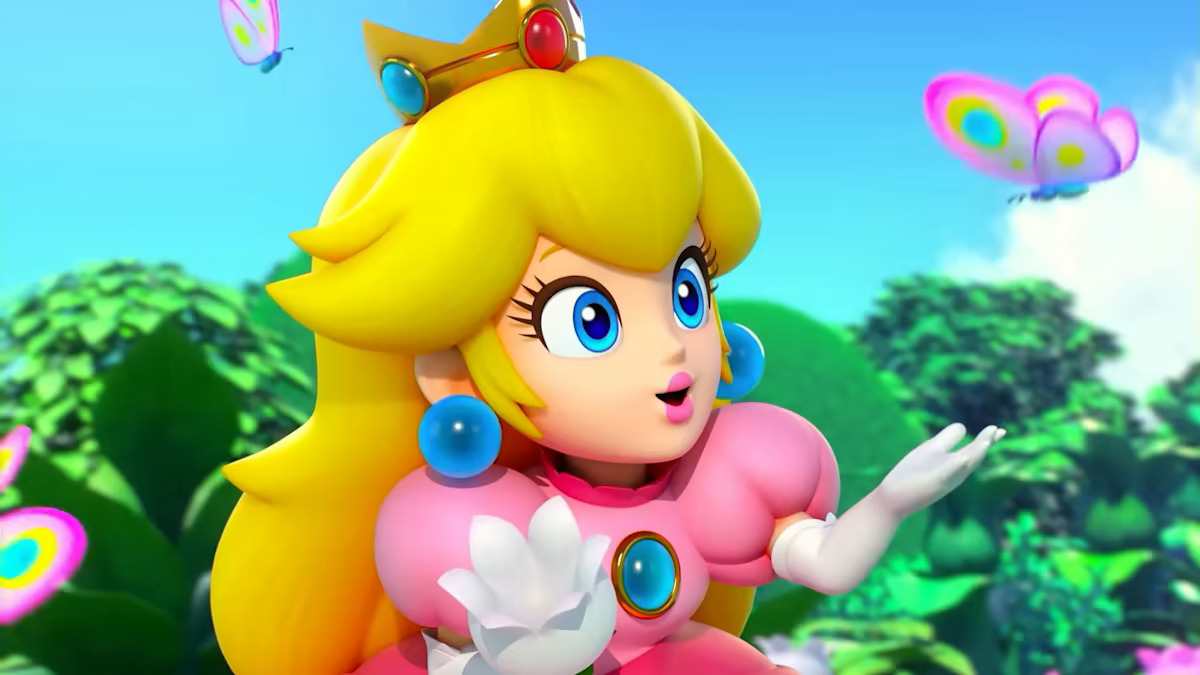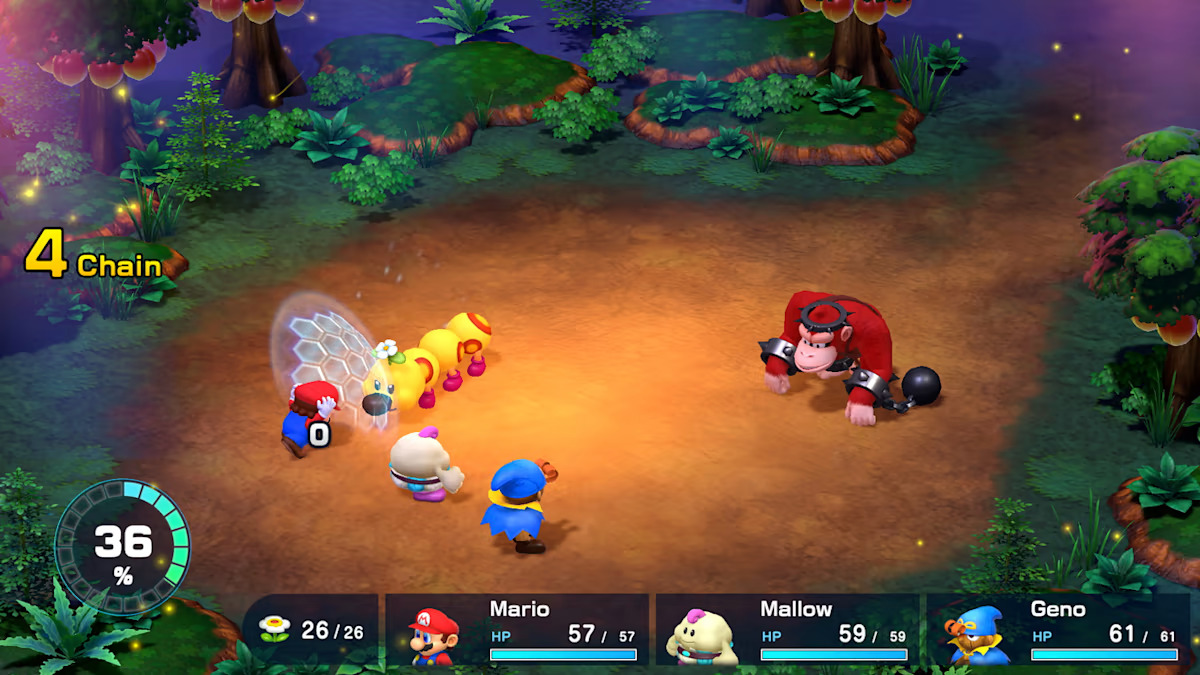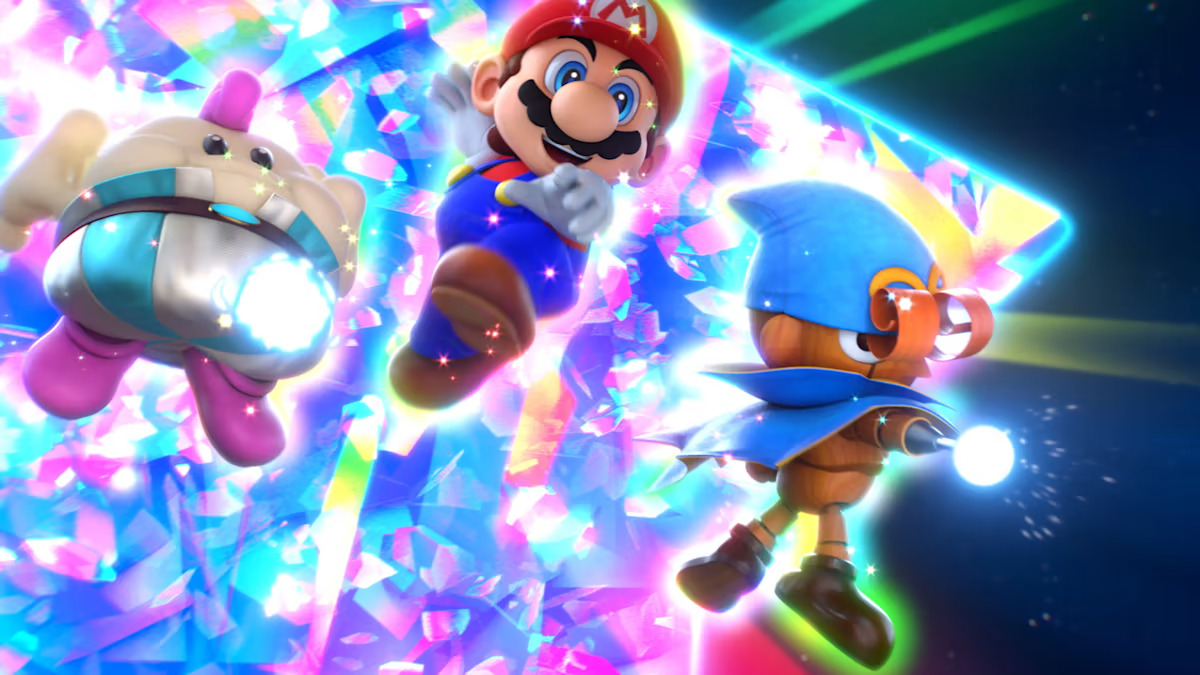
Super Mario RPG The Legend of the Seven Stars was released on the Super Nintendo Entertainment System in 1996. A whopping 27 years later, the beloved turn-based classic returns exclusively on the Nintendo Switch, with the much more succinct title, Super Mario RPG. This isn’t a straight-up re-release though, it’s a remake from the ground up, with completely overhauled graphics, updated music, and some minor improvements to an almost near-perfect game that aged phenomenally.
Super Mario RPG is published by the console’s own company, Nintendo, and developed by ArtePiazza with some supervision from the original developer, Square, now known as Square Enix. The devs sought to produce a loving recreation of a classic of Nintendo’s history, and they absolutely nailed it. Originally a collaboration between Nintendo and RPG megastars of Final Fantasy fame, Square, the Super Mario RPG (1996) was an adventure way before its time. The story and gameplay have managed to stay relevant, and there was very little in the new version that even required improvements, save a few modernisations, so the story, combat, and overall feel remain intact. It’s an almost frame-by-frame recreation, which works surprisingly well given the difference in gaming eras. The real kicker is the original was not released in Europe, Australia, or any other PAL regions until the Wii Port in 2008, and for many, this may be their first foray into a fondly remembered title.
For anyone familiar with the tale of Mario rescuing Peach from the clutches of mega monster, Bowser, you’ll be familiar with how the story begins. It doesn’t take long to see the trope turned around. After the usual valiant act of rescuing the aforementioned princess, a massive sword falls from the sky, lodging itself into Bowser’s castle, and forcing Mario’s arch-nemesis out. This sentient sword who goes by the name Smithy, and his various crew seek to take over not just the castle, but absolutely every territory in the land. To stop him, the plumber, ever performing beyond his scope of work, must join forces with allies and enemies alike, venture through the world, and collect the Seven Stars to restore balance and destabilise Smithy’s hostile takeover.

Super Mario RPG’s most significant change from the original title is the graphics. The overhaul takes the isometric, 16-bit faux-3D graphics of the 1996 game and upgrades it to a beautifully rendered 3D. As to be expected, there’s a massive amount of polish we’ve come to know and love from Nintendo titles. This isn’t a mere port riding the wave of nostalgia, rather, a full visual facelift, while still retaining all the original charm all in a wonderfully vibrant package. A highlight is the added 3D animated cutscenes. While they’re fairly rare, between team-up attacks and a few key moments, they are stunning cinematic masterpieces.
Mario is tasked to travel to each region while collecting the Seven Stars and battling it out against the enemies plaguing the land. Each level has updated visuals, from the Mushroom Kingdom, a ghostly pirate ship, and a volcanic domain, all areas are faithful to their original design, which was already terrific. Regions are diverse, vibrant, and full of all matter of critters and contraptions to play with.
The much-beloved world selection menu returns, acting as the gateway to each zone. For added convenience, a quick trip to the game menu map allows for fast travel to any area, and no area is too big that it overstays its welcome, so it’s easy to navigate the world. I appreciate a pared-down RPG where getting around is easy and there isn’t too much unnecessary space. There are still secrets to find and some great platforming variations, and while the game world is very linear, it never feels repetitive.
The original music of Squares’ RPG master composer, Yoko Shimomura, has been reworked. The enhanced instrumentation takes the classic chip-tunes of the 1996 game and brings them into a beautifully orchestrated symphony. It feels authentic to an RPG but with plenty of callbacks to the Mario soundtracks. Combat music tends to get repetitive as the only variation occurs when in a boss battle, but fights are generally quick enough that it’s relatively easy to disregard.
The original soundtrack can be toggled in the menu for those who prefer the classic style in their travels, and of course, a Mario game would not be complete without the iconic sounds of its characters, worlds, and items. There are also plenty of audio cues for power-ups, during combat, and movement, a quality of life improvement, alongside visual cues to help combat actions feel more impactful and noticeable.

While there’s no voice acting, characters are ridiculously expressive in their movements, making both friends and foes alike a joy to watch. There’s more showing rather than telling which I appreciated as RPGs tend to get overly dialogue-heavy, and there’s no real need to skip through conversations – the limited dialogue was always entertaining. My favourite that comes to mind is Booster, who seems to be blissfully unaware of what marriage is, yet proceeds to hold Peach captive and is set to wed, ultimately resulting in an ill-fated fight against a giant cake.
The adventuring party is an awesome line-up, including Mario, Peach, and the unlikely ally, Bowser, alongside two new companions, the clumsy and adorable Mallow and Geno, a mysterious possessed wooden doll. There’s a surprising amount of strategy at play and a huge catalogue of enemies with different weaknesses and resistances that require tailored approaches to each scenario. A good team composition is essential, and striking the balance of physical attackers, magic users, and healers had me pummeling enemies within seconds. Heroes have unique specials that are activated in interesting ways – Geno’s require holding down ‘A’ until a bar is filled, and Mario’s jumps require precision reaction for a button prompt. It’s satisfying to see a well-planned attack eviscerate enemies.
Levelling doesn’t require much of a grind, and I easily gained EXP running through each zone mercilessly killing all my foes. Combat can be speedy once you know the best tactics for each scenario, and towards the end game, I was ridiculously overpowered. This is in part thanks to being able to choose what stats to spec into during level-ups, allowing each type of hero to be used to the best of their ability, and character-specific gear, such as gloves that allow Bowser to hurl Mario at enemies during an attack, or Peach delivering a crisp slap to a poor Goomba helped even more. The real highlight in combat is the bosses; an encounter with one of Smithy’s lackeys resulted in the Switch buttons becoming “turned off,” and on one occasion, a very confused bird couldn’t figure out what was not quite right in a room, resulting in a surprisingly stressful “stealth” scenario.
Overall combat is incredibly satisfying and involves significantly more strategy than I anticipated. It wasn’t until I learned to be reactive rather than the usual passive of turn-based combat that I was able to fully appreciate encounters.

A well-timed press of a button prompt can completely block an oncoming attack or boost damage to enemies. There are some devastating attacks that target your whole team, so having a good healer or buffs at the ready is crucial. Chaining attacks builds up the Triple Move Gauge, allowing for a powerful group attack formation based on the current party. Combat doesn’t steer too far from the usual turn-based formula, but how the game presents each situation, as well as how to approach them, keeps everything fresh.
Gameplay rarely gets stale with plenty of mix-ups to exploration, activities, and a good dose of secrets, so there were no real dull moments. My main frustration was with some mini-games and challenges, which require skill, precision, and patience, of which I have none. Succeeding in these sections often required platforming, and with the isometric angles, I found myself falling off blocks when my perspective was off, but it was worth the struggle for some of the rewards granted. The game can be played on two difficulty settings, Breezy and Normal, and for those wanting more of a challenge, the post-game content brings modified instances of previous battles. Super Mario RPG jumps to the occasion of creating an RPG that’s easy to understand and accessible. For more hardcore RPG fans, they might not find enough challenge and complexity here.
I had no notable performance issues and virtually no load times as I travelled between areas, and the game remained stable with very few graphical and performance drops. Everything looked and ran well, both docked and handheld, and the controls are easy to learn, with plenty of prompts and simplistic menus. It’s also nice that players have the option of using the modernised control scheme or toggle to classic if preferred.
Super Mario RPG is a light-hearted jaunt into the long-standing, much-adored Mario universe. It took me roughly 12 hours to finish the game without exploring every nook and cranny. For completionists, it could potentially take around 15 or so. Personally, the runtime was fine as nothing felt drawn out. RPGs, these days, tend to run upward of 80 hours, and for Mario, anything more than 20 hours would become tiresome. Simple and effective, I would call it a great family-friendly RPG lite title, fit for fans and newcomers alike. It’s an adventure full of whimsy, heart, and fun, and a stellar reintroduction of a classic.

The Good
- Faithful, loving rework of a classic title
- Innovative gameplay
- Gorgeous visuals and audio
The Bad
- Gameplay length may be too short for some
- Some platforming and puzzles can be frustrating








